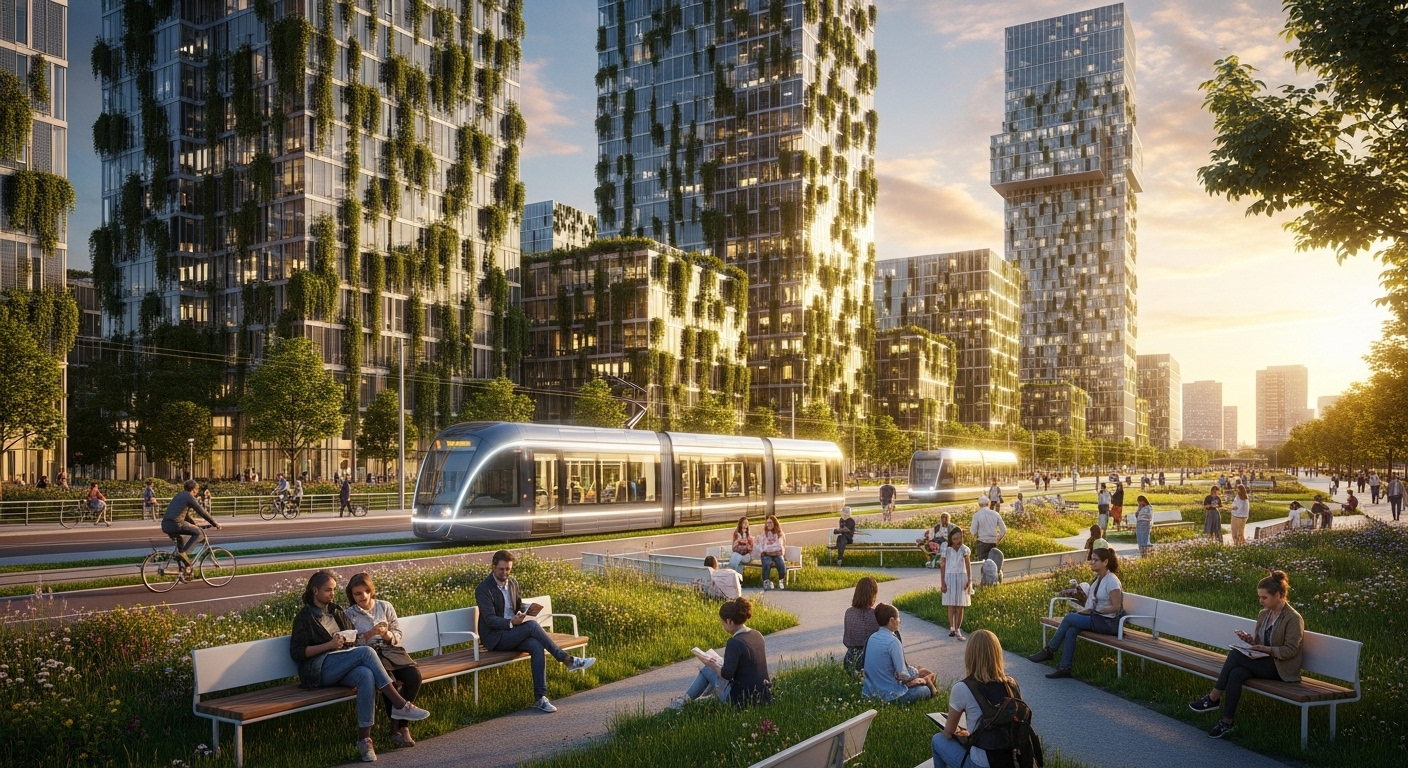The monolithic glass tower, once the undisputed symbol of corporate power, no longer defines Europe’s leading business districts. In the wake of a global shift in work culture, a new, more dynamic model is emerging. The post-pandemic era has accelerated a profound transformation, moving the focus from sheer commercial density to the creation of holistic urban ecosystems. Today, the most successful business districts are not just places of work; they are vibrant, multi-purpose hubs designed to attract and retain top talent, integrate cutting-edge technology, and champion environmental sustainability. This evolution reflects a deeper understanding that long-term economic resilience is intrinsically linked to human well-being and planetary health. This article explores this new paradigm, examining how a powerful trifecta of talent, technology, and sustainability is redefining the continent’s most influential economic centers, from the historic streets of London to the innovative corridors of Berlin and Amsterdam.
Beyond the glass tower: redefining the central business district
The concept of the Central Business District (CBD) is undergoing a fundamental reinvention. Historically characterized by a high concentration of office buildings and financial institutions, these areas often became sterile and deserted after office hours. The new urban core, however, is being reimagined as a dynamic, mixed-use environment that thrives around the clock. This shift is heavily influenced by urban planning concepts like the ’15-minute city,’ pioneered in Paris, which aims to provide all necessary amenities—work, housing, shopping, and leisure—within a short walk or bike ride. This model prioritizes people over cars, fostering a greater sense of community and reducing dependency on public transport. As companies adopt hybrid work models, the office itself is changing. It’s no longer just a place for individual work but a hub for collaboration, innovation, and fostering corporate culture. This has led to a ‘flight to quality,’ where businesses are seeking premium, well-located, and highly-amenitized buildings that offer more than just a desk. These new districts are integrating residential spaces, retail, cultural venues, and green parks, creating a seamless blend of work, life, and recreation that attracts a diverse population, not just a transient workforce.
The talent magnet: creating environments for the modern workforce
In today’s competitive global market, talent is the ultimate currency. European business districts are recognizing that attracting and retaining the best minds requires more than just high salaries. The modern workforce, particularly in the tech and creative sectors, prioritizes quality of life, work-life balance, and a sense of purpose. Successful districts are becoming ‘talent magnets’ by creating environments that cater to these needs. Dublin’s ‘Silicon Docks,’ for example, has become a European hub for major tech companies partly because of the vibrant, youthful, and international culture it fosters. Similarly, Berlin’s appeal lies in its unique blend of affordability, creative energy, and collaborative startup culture. These locations understand that the workplace experience extends beyond the office walls. They are rich in amenities, offering everything from world-class restaurants and fitness centers to cultural institutions and accessible green spaces. This focus on the holistic employee experience helps build a strong sense of place and community, making these districts not just a location to work, but a desirable place to live. This approach creates a virtuous cycle: a high quality of life attracts talent, which in turn attracts more innovative companies, further enhancing the district’s appeal.
The digital foundation: integrating smart technology and innovation
Technology is the central nervous system of the modern business district. To support the demands of a digital-first economy and a hybrid workforce, a robust and intelligent infrastructure is essential. This goes far beyond high-speed internet access. Leading districts are becoming ‘smart cities’ in their own right, integrating IoT (Internet of Things) and AI to optimize everything from energy consumption and traffic flow to space utilization and public safety. Amsterdam’s Zuidas district is a prime example, pioneering smart solutions that enhance both sustainability and the user experience. Smart buildings are now a key feature, offering advanced connectivity, touchless entry systems, and data analytics that help companies understand how their spaces are being used, allowing them to adapt their real estate footprint dynamically. This technological integration is crucial for creating a seamless experience between employees working in the office and those connecting remotely. It ensures that collaboration can happen effortlessly, regardless of physical location. By embedding technology into their very fabric, these districts are not only boosting efficiency and productivity but also future-proofing themselves for the next wave of technological innovation.
The green imperative: why sustainability is now non-negotiable
The push for sustainability has moved from a corporate social responsibility talking point to a core business imperative. Environmental, Social, and Governance (ESG) criteria are now major drivers in the commercial real estate market, with both investors and tenants prioritizing environmentally responsible properties. Business districts are at the forefront of this green transition. There is a strong focus on decarbonizing the built environment through the construction of green buildings with certifications like BREEAM or LEED, which guarantee high standards of energy efficiency and sustainable materials. The Nordic capitals are leaders in this regard, with cities like Stockholm and Copenhagen becoming hubs for ‘climate tech’ and green innovation. The sustainability agenda also involves retrofitting older buildings to meet modern environmental standards, reducing the carbon footprint of existing infrastructure. Beyond the buildings themselves, districts are promoting biodiversity with green roofs, creating more parks, and encouraging sustainable transport options like cycling and walking. This green imperative is not just an ethical choice; it’s a strategic one. Sustainable districts are more resilient, cost-effective to operate, and increasingly, the only places where top-tier talent and forward-thinking companies are willing to be.
Legacy leaders in transition: the evolution of London and Paris
Established financial powerhouses like London and Paris are not standing still; they are actively reinventing themselves to align with the new urban core principles. London’s City and Canary Wharf districts, long the epicenters of global finance, are adapting to the demands of the tech and creative industries. This involves not only upgrading buildings with smart technology but also enhancing the public realm to create more inviting and collaborative spaces. There is a growing focus on ‘impact tech’—startups that aim to solve social and environmental problems—which aligns with the city’s broader sustainability goals. Similarly, Paris La Défense, Europe’s largest purpose-built business district, is undergoing a major transformation. It is diversifying its tenant base beyond finance and investing heavily in green infrastructure and improved connectivity to the city center. The rise of Station F, the world’s largest startup campus, signals Paris’s growing stature as a major tech hub. These legacy districts are leveraging their existing infrastructure and global brand recognition while integrating the principles of sustainability, technology, and talent-centric design to maintain their competitive edge in a rapidly changing world.
The challenger cities: a new benchmark for liveability and growth
While legacy cities adapt, a new wave of ‘challenger’ cities is setting a fresh benchmark for what a modern business district can be. These hubs, often with a strong focus on technology and quality of life, are attracting significant investment and talent. Amsterdam’s Zuidas district has rapidly become one of Europe’s most desirable business locations, thanks to its strategic location, business-friendly environment, and highly skilled, English-speaking workforce. The city’s commitment to smart city solutions and sustainable living is a major draw. Berlin has solidified its reputation as a premier tech hub, attracting entrepreneurs and creatives with its relatively low cost of living and vibrant, collaborative atmosphere. Its focus on green technology and renewable energy positions it as a leader in the sustainable economy. Dublin, with its ‘Silicon Docks,’ has successfully attracted the European headquarters of numerous global tech giants, creating a dynamic, high-paying ecosystem. These challenger cities demonstrate that a holistic approach—one that balances economic growth with sustainability and a high quality of life—is the most effective strategy for success in the 21st century.
The era of the single-purpose business district is over. The future of European commerce is being built in dynamic, resilient, and human-centric urban cores that function as complete ecosystems. The most successful districts are those that have masterfully woven together the threads of talent, technology, and sustainability. They are creating environments where people want to live, not just work, fostering innovation through smart infrastructure and collaboration. More importantly, they are embracing their role in building a more sustainable and equitable future. By prioritizing well-being and environmental stewardship alongside economic output, these hubs are not just creating value for their resident companies; they are setting a new global standard for what a prosperous and liveable city can be. For business leaders and urban planners alike, the message is clear: the path to long-term success lies in building integrated communities, not just commercial real estate.





